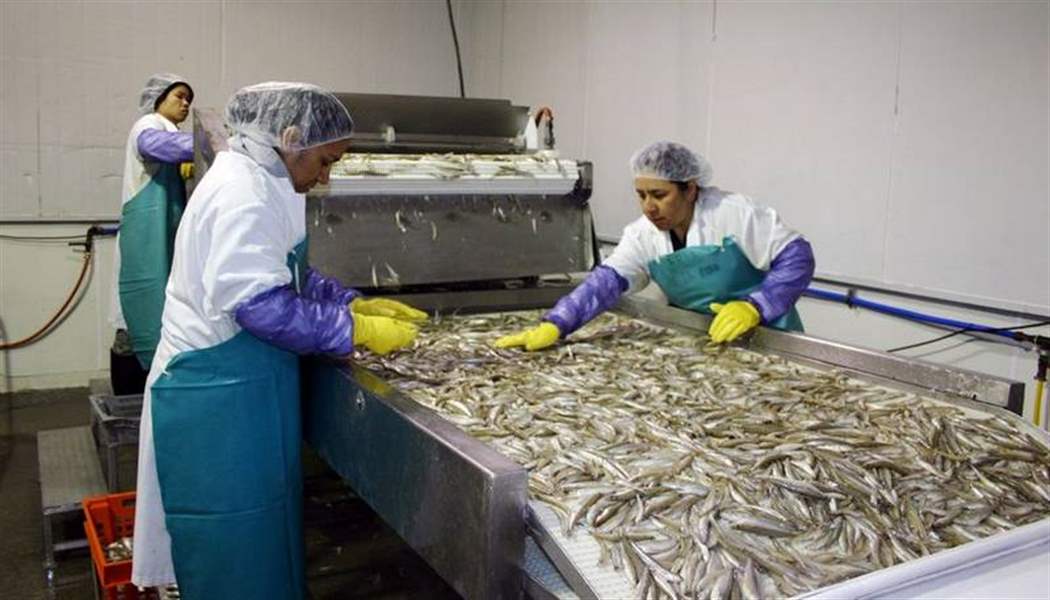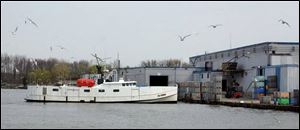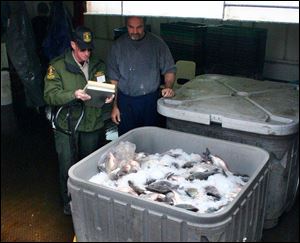
Fishermen on both sides of Lake Erie fret over livelihood
5/26/2008
At Presteve Foods in Wheatley, Ont., workers sort through a catch of fish brought to the Canadian shore earlier in the day.
 Forums to talk about this story." rel="storyimage1" title="Fishermen-on-both-sides-of-Lake-Erie-fret-over-livelihood.jpg"/>
Forums to talk about this story." rel="storyimage1" title="Fishermen-on-both-sides-of-Lake-Erie-fret-over-livelihood.jpg"/>
A commercial fishing boat prepares to dock and unload its catch from Lake Erie at the fishing port of Wheatley, Ont. (PHOTO BY TOM HENRY) <br> <img src=http://www.toledoblade.com/graphics/icons/forum.gif> <b><font color=red>TALK BACK</b></font color=red>: Join <a href=" /apps/pbcs.dll/news_themes?Category=FORUMS" target="_blank "><b>Forums</b></a> to talk about this story.
WHEATLEY, Ont. - Commercial fishing is a dying industry on the U.S. side of Lake Erie, but it remains big in Canada, with an annual harvest of 36 million pounds.
But for how long?
Peter Meisenheimer, Ontario Commercial Fisheries' Association executive director, wondered that as he stood on a dock in Wheatley, Ont., the world's largest freshwater fishing port, in the shadow of a Canadian fishing vessel returning with its morning catch.
Fuel costs are rising. But that's not what bothers Mr. Meisenheimer the most.
The big-picture issue to him is the inherent power of the American sport-fishing indus-try, and the degree to which it may influence management decisions on both sides of the border.
Is North America's most productive freshwater lake being managed with a bias toward the recreation and tourism industries? Or can those who fish for a living still thrive?

Such questions have lingered for years. But they loom larger as costs rise, the economy worsens, and more restrictions are imposed.
In January, a new group called Great Lakes Commercial Fishermen LLC filed a lawsuit against the state of Ohio in U.S. District Court in Toledo, alleging the Ohio Department of Natural Resources is conspiring to dismantle what's left of Ohio's commercial fishing industry by regulating it to death.
That action was preceded in Canada by a lawsuit commercial fishermen filed last fall against the Ontario Ministry of Natural Resources, alleging the province simply rubber-stamps recommendations it gets on catch limits from a binational advisory committee.
"It's not like everything is skittles and beer up here," Mr. Meisenheimer said, comparing Ontario's commercial fishing industry to Ohio's. "We're suing the government ourselves."
Though his association sued Canada's largest province, its real beef is with American fish managers who represent their states on the Lake Erie Committee of the Great Lakes Fishery Commission.

At Presteve Foods in Wheatley, Ont., workers sort through a catch of fish brought to the Canadian shore earlier in the day.
Mr. Meishenheimer's group claims that committee "has morphed into a politically driven management agency with no legal mandate and no accountability," an accusation that committee members dispute.
The Great Lakes Fishery Commission of Ann Arbor was founded by the United States and Canada in 1955 to combat the dreaded sea lamprey's assault on lake trout and other fish. It also was created for networking information about exotic species and general fishing issues.
Now operating on a $20 million annual budget, its five lake committees have made recommendations on management issues since 1965. It was accused of acting beyond its constitutional scope in formal complaints filed in 1997 and 2005. Both were dismissed.
Frank Reynolds, a commercial fisherman from Oregon involved in the 1997 challenge, has accused lake committees of becoming "the absolute power" through the policy consensus they deliver to state and provincial governments.
Similar allegations were raised in 2005 by Wolf-Dieter Busch, a Maryland consultant and longtime U.S. Fish and Wildlife Service scientist with years of fisheries management experience along the gulf coast, the Great Lakes, and the Atlantic seaboard.

Commercial fishermen bring their cargo of fresh fish on ice into Wheatley, Ont. More than 85 percent of the fish taken by commercial fishermen in Ontario is exported to the U.S.
He said the committees wield great influence, whether it's tinkering with the ratio of predators to prey or relying too heavily on hatchery-produced fish.
Mr. Busch also challenged the commission's scope in a 2003 peer-reviewed article for a scholarly journal published by the University of Toledo's Legal Institute of the Great Lakes, and wrote a 1998 paper on the topic.
But as commission spokesman Marc Gaden has noted, the lakes - shared by eight states, two provinces, two nations, and Native American tribes - are unique in that no significant part of them is deemed federal waters. The opposite is true for the oceans and the Gulf of Mexico.
One of the most important jobs for the fishery commission's five lake committees is to recommend catch limits. They're based on what officials believe must be done to at least maintain, if not rebuild, the region's fish population.
This year, the Lake Erie Committee has called for a more restrictive quota on yellow perch, which is walleye's equal as a prized catch.
Ultimately, decisions on catch limits have been complicated by the cultures and traditions of the United States and Canada, plus those of tribal nations.
Mr. Meisenheimer said the two countries have different fishing priorities because of an "accident of geography" which has resulted in lopsided populations of near-shoreline residents.
Canada's Lake Erie shoreline is dotted by quaint villages such as Port Burwell, Port Stanley, Kingsville, New Glasgow, Eatonville, and Cedar Springs.
Compare that to the U.S. side. There are several cities with populations of 100,000 or more people along the lake, including Toledo, Cleveland, Erie, Pa., and Buffalo, plus more - such as Detroit, Ann Arbor and Akron - that are a short drive away. And there are a number of midsized American cities along or near Lake Erie, such as Sandusky, Port Clinton, and Monroe.
Ontario has few natural harbors and few boat launches along Canada's Lake Erie shoreline. It also has 250,000 inland lakes for anglers to choose from, said Mike Morencie, chief of Ontario's Lake Erie management unit. He's also a member of the Lake Erie Committee.
Roger Knight, the Ohio DNR's Lake Erie fisheries program administrator, is Ohio's representative on the committee.
"We treat quotas like caps, not goals," he said. "The fact of the matter is our fish supplies have been compromised by a lot of environmental factors."
Quotas can be controversial, depending on the perspective.
Mr. Knight said people often forget how productive the lakes once were and accept current populations as the norm. He said officials are fair to both the commercial and sportfishing industries - yet acknowledged the sportfishing industry's $800 million economic impact on Ohio. It overshadows the estimated $10 million in benefits the state receives from its commercial fishing industry.
Forty percent of Ohio's catch is taken by the commercial fishing industry, even though the state issues only 18 licenses for trap nets and 30 licenses for seine nets, he said.
Ohio licensed 400,000 anglers and 796 charter boat captains last year.
"We're not aware of anybody in Ohio who's gone out of business for economic reasons," Mr. Knight said.
Ontario issues 514 commercial fishing licenses. More than 85 percent of the fish netted by commercial fishermen in Ontario is exported to the United States, Mr. Morencie said.
Ohio cracked down on commercial fishing in 2005. Most charges related to illegal marketing of yellow perch.
"The violations were serious and extensive," Mr. Knight said.
Contact Tom Henry at:
thenry@theblade.com
or 419-724-6079.